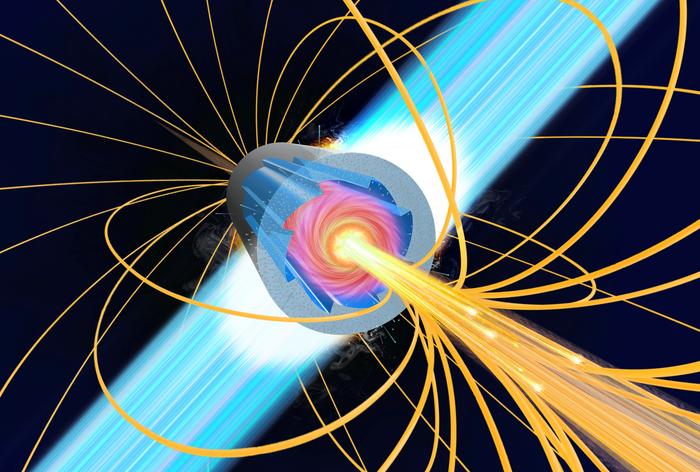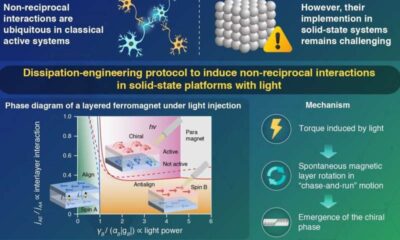Science
Japanese Physicists Aim to Generate Megatesla Magnetic Fields in Labs

Researchers at the University of Osaka in Japan have proposed a groundbreaking method for generating extraordinarily strong magnetic fields, potentially reaching the megatesla range. These fields, normally observed only in astrophysical jets and highly magnetized neutron stars, could now be produced in laboratory settings using a novel approach. The technique involves directing intense, ultrafast laser pulses into a specially designed hollow tube equipped with sawtooth-like inner blades.
The method builds on the established concept of “microtube implosion,” which utilizes femtosecond laser pulses to create conditions conducive to high-energy-density processes. Previous experiments have demonstrated that advanced ultra-intense lasers can generate magnetic fields of several kilotesla. The latest research indicates that a suite of enhanced laser technologies, combined with intricate microstructures, can push these limits even further.
Innovative Microtube Design Enhances Magnetic Field Generation
In the microtube implosion technique, femtosecond laser pulses with intensities ranging from 1020 to 1022 W/cm2 target a hollow cylindrical area with an inner radius of 1 to 10 mm. This setup creates a plasma of hot electrons with mega-electron volt (MeV) energies that form a sheath field along the tube’s inner wall. As these electrons accelerate ions radially inward, the cylinder implodes, leading to the generation of a magnetic field.
Traditionally, this technique requires a kilotesla-scale “seed” magnetic field, complicating the apparatus and resulting in a bulky design. The innovative research led by Masakatsu Murakami and colleagues proposes a new setup that eliminates the need for this seed field. Instead, they suggest using a micro-sized cylinder with a periodically slanted inner surface featuring sawtooth-shaped blades. This design introduces geometrical asymmetry, which causes the imploding plasma to swirl asymmetrically, generating circulating currents at the cylinder’s center.
Using “particle-in-cell” simulations executed on the SQUID supercomputer with the fully relativistic EPOCH code, the researchers discovered that these vortex structures are created through a self-consistent positive feedback mechanism. The initial loop current amplifies the central magnetic field, which in turn constrains the motion of charged particles more tightly, further enhancing the loop current.
Potential Applications and Future Experiments
“This approach offers a powerful new way to create and study extreme magnetic fields in a compact format,” stated Murakami. He emphasized the significance of this research as it bridges the gap between laboratory plasmas and astrophysical phenomena. The implications of this work could extend to controlled studies of strongly magnetized plasmas, relativistic particle dynamics, and magnetic confinement schemes relevant to both fusion energy and astrophysics.
The findings have been reported in the journal Physics of Plasmas. Researchers are now focused on implementing their proposed setup in experiments utilizing petawatt-class lasers. Murakami expressed enthusiasm for the next steps, stating that they will also explore how these powerful magnetic fields can be employed to steer particles or compress plasmas.
As this research progresses, it may pave the way for significant advancements in our understanding of high-energy-density physics and its applications in various scientific fields.
-

 Entertainment3 months ago
Entertainment3 months agoAnn Ming Reflects on ITV’s ‘I Fought the Law’ Drama
-

 Entertainment4 months ago
Entertainment4 months agoKate Garraway Sells £2 Million Home Amid Financial Struggles
-

 Health3 months ago
Health3 months agoKatie Price Faces New Health Concerns After Cancer Symptoms Resurface
-

 Entertainment3 months ago
Entertainment3 months agoCoronation Street’s Carl Webster Faces Trouble with New Affairs
-

 Entertainment2 weeks ago
Entertainment2 weeks agoCoronation Street Fans React as Todd Faces Heartbreaking Choice
-

 Entertainment3 months ago
Entertainment3 months agoWhere is Tinder Swindler Simon Leviev? Latest Updates Revealed
-

 World2 weeks ago
World2 weeks agoBailey Announces Heartbreaking Split from Rebecca After Reunion
-

 Entertainment4 months ago
Entertainment4 months agoMarkiplier Addresses AI Controversy During Livestream Response
-

 Science1 month ago
Science1 month agoBrian Cox Addresses Claims of Alien Probe in 3I/ATLAS Discovery
-

 Health5 months ago
Health5 months agoCarol Vorderman Reflects on Health Scare and Family Support
-

 Entertainment4 months ago
Entertainment4 months agoKim Cattrall Posts Cryptic Message After HBO’s Sequel Cancellation
-

 Entertainment3 months ago
Entertainment3 months agoOlivia Attwood Opens Up About Fallout with Former Best Friend




















